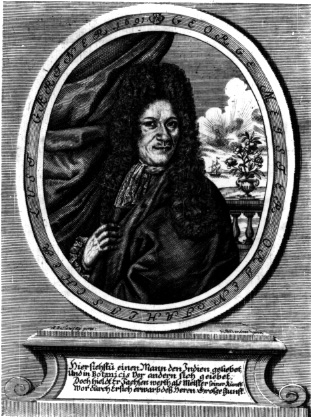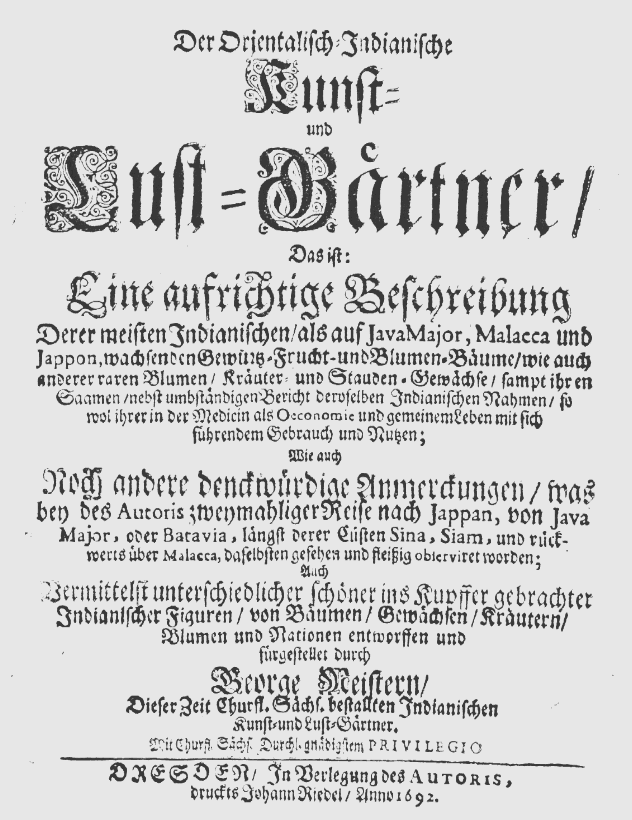|
George (or Georg) Meister
(1653-1713) was one of the 17th century's first garden-explorers whose travels and
horticultural investigations in the Orient inspired a later generation such as
Van
Rheede and Kaempfer. Meister was
a keen gardener from Dresden, Germany who decided to visit the far east. The
only way to do so was, at that time, to inscribe as a soldier in the
Dutch East
India Company. He thus travelled to India in 1677 and also investigated the
Cape of Good Hope, Java, Molucca, and Japan, from both horticultural and linguistic perspectives. The head of the Dutch colony in Batavia (now Djakarta, Indonesia) at that time was Andreas Cleyer (see below), who hired Meister as his gardener. Meister collected samples of most of the trees and herbs of Indonesia, and would later list them together with their original names in his book. The pair made two visits to Japan in October 1682-November 1684 and October 1685-November 1687 when Cleyer was Opperhoofden (chief commissioner) of the Dutch trading post there. In 1689 Meister was back at Dresden, Germany. He wrote an account of his adventures and collections in his 1692 book, Der Orientalisch-Indianische Kunst und Lust-Gärtner (Oriental-Indian art and pleasure gardener). In addition to South East Asian plants, he also described a series of Japanese plants in chapter ten, 'Japponische Baumschule' ('Japanese Nursery'). All told he gave eighty-eight descriptions. The work contains the first European description of both Japanese dwarf potted plants and the Camellia japonica. Cleyer (1634-1698) was a licensed physician from Kassel, who lived in Batavia after 1662 in the service of the Dutch East India Company. He was well known as the first European botanist who studied the Flora of Japan when he was head of the medical service at Dejima where the company had a trading post on that island in Nagasaki harbor. Assisted by Meister, Cleyer conducted intensive research on Japanese materia medica and sent letters, sketches, and botanical samples to scholars in Germany and the Netherlands. His notes were published in the journal Miscellanea Curiosa between the years 1686 and 1696. After his journey to Java, he devoted himself to botany. Specimen Medicinae Sinicae sive opuscula medical ad mensem sinensum (Example of Chinese Medicine, or brief works on medicine in the Chinese spirit), also published in 1692, consists of translations from Chinese medical works by Fr. Michael Boym that were then edited by Cleyer. This was a major contribution to the understanding of Chinese medicine. It should be noted, however, that the method of description used by both Meister and Cleyer was far below the accepted level of the time. No reference was made to any of the standard works; the flowers and leaves are insufficiently described (though Cleyer provided somewhat more detail than Meister); most of the descriptions consist of details about the medical and economic value of the plants; Meister sometimes adds anecdotal material; and while Cleyer's descriptions are badly illustrated, Meister's are not illustrated at all. Future botanists, except those interested in the history of botany, took little notice of these two. In 1689 the German Engelbert Kaempfer (1651-1716) arrived in Batavia. While he was looking for his next position in the service of the East India Company, he stayed at Cleyer's house. Soon the small community of educated people in Batavia knew about his long journey from Sweden via Persia and India to the East and the scientific observations he had made during these years. As there was an urgent need for comprehensive, up-to-date data about Japan they drew Kaempfer's attention to the trading post in Nagasaki. Before leaving for Japan he received careful instructions and a list of books, plants samples and objects to be collected in Japan. A Chinese translation of this list was to help in conveying these requests to the Japanese. Among the travellers to Japan during the seventeenth century Kaempfer was the most experienced observer, with a rich knowledge of non-European cultures that enabled him to make comparisons and to put things into a broader perspective. (Tea was brought to Indonesia in 1686 by the Dutchman Cleyer. However, it was introduced as a decorative plant, not as a beverage. In 1728 the Dutch colonial government began to bring in tea seeds in large quantities from China to be cultivated in Java. It was not successful until Dr. Van Siebold, a surgeon in the colonial Dutch army, who had conducted natural research in Japan, used tea seeds from Japan in 1824. The first tea plantation was pioneered by Jacobson in 1828 and, after that, tea became a very profitable commodity to the colonial Dutch government.) 1 |

|

|
|
Der Orientalisch-Indianische Kunst und Lust-Gärtnern
(1692):
"In den großen runden Steinen und Klippen haben
sie einen Fuß tief runde oder länglichte Löcher, welche sie mit Erde füllen und hernach
ihrer Art kleine Bäumgen hineinpflanzen, welche zum Teil Früchte, die meisten aber
allerhand Art schöne und wohlriechende Blumen tragen, wie auch allerhand Zwiebelgewächse,
welche ziemlich rar und angenehm zu sehen sind, ..." |
|
1
"1907 - 2007, 100 Jahre Bonsai in Deutschland,"
http://www.100-jahre-bonsai.de/geschichte.html;
Michel, Wolfgang "Far Eastern Medicine in Seventeenth and Early Eighteenth Century
Germany.&bsp; Studies in Languages and Cultures" (Faculty of Languages and
Cultures, Kyushu University), No. 20 (2004), pp. 67-82,
http://www.flc.kyushu-u.ac.jp/~michel/publ/aufs/73/73.htm,
See footnote 19;
"Georg Meister,"
http://www.med-rz.uni-sb.de/med_fak/physiol2/camellia/treasury/zuwacky.htm;
http://clendening.kumc.edu/dc/rti/human_body_1682_cleyer.html;
"C123. Preparation for Lecture 10. a) Transmission of Asian Medicine to Europe,"
https://www.ucl.ac.uk/histmed/PDFS/Teaching/MA/chinese/C123-Lecture10a.pdf;
Peper, Klaus "Camellia Documents and Events till 1699,"
http://camellia-ics.org/_ics/biblio/camdoc0.htm;
"history of tea," http://www.sosro.com/Index_english.htm.
2 Translation assistance by Bianca Cameron, Eyes Out Front (
http://eyesoutfront.proboards62.com/ ), 05 Feb 2007,
for RJB.
|